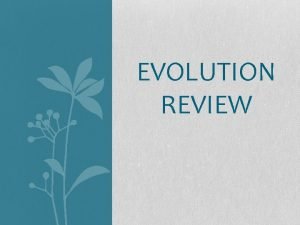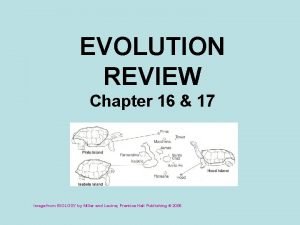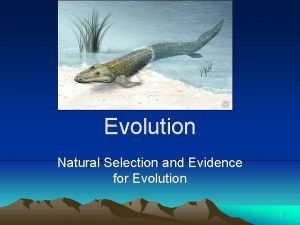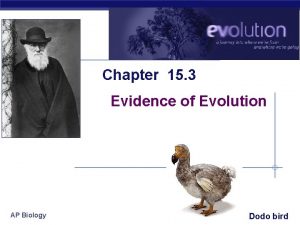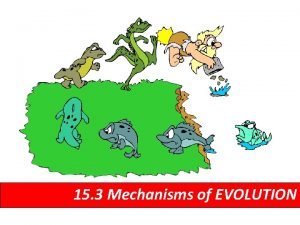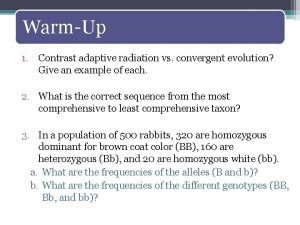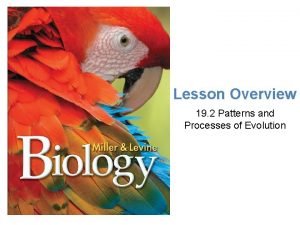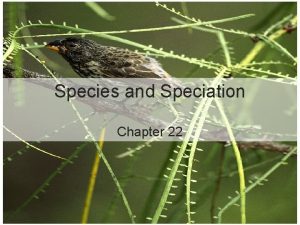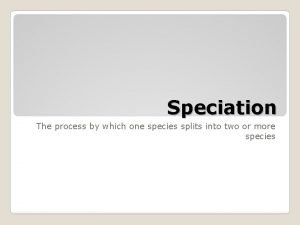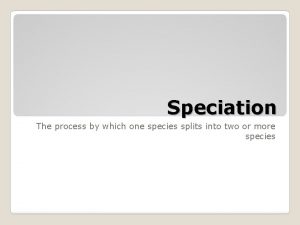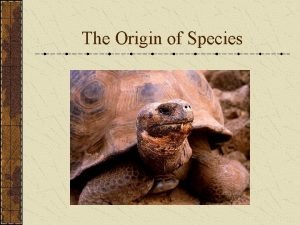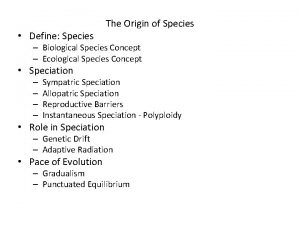Evolution Adaptive Radiation When one species splits into












- Slides: 12

Evolution

Adaptive Radiation • When one species splits into many species to fill open habitats. – Darwin’s finches

Speciation • One species can evolve into two or more species • 2 step process – Geographical isolation – Reproductive isolation When a group becomes geographically isolated over time it will become reproductively isolated = new species formed.

Ammospermophilus spp Geographic isolation • When a population becomes divided by a natural barrier. • Mountains, river, body of water, landslides • Groups can’t interbreed or intermix • Become adapted to a different environment Harris’s antelope squirrel inhabits the canyon’s south rim (L). Just a few miles away on the north rim (R) lives the closely related whitetailed antelope squirrel

Reproductive Isolation • Differences in isolated groups become so great, they can no longer interbreed – Physical changes – Behavioral changes – Biochemical changes

Rate of Speciation • Current debate: Does speciation happen gradually or rapidly – Gradualism • Charles Darwin • Charles Lyell – Punctuated equilibrium • Stephen Jay Gould • Niles Eldredge Curator American Museum of Natural History

Gradualism • Gradual divergence over long spans of time – assume that big changes occur as the accumulation of many small ones

Punctuated Equilibrium • Rate of speciation is not constant – rapid bursts of change – long periods of little or no change – species undergo rapid change when they 1 st bud from parent population Time

Stephen Jay Gould (1941 -2002) • Harvard paleontologist & evolutionary biologist – punctuated equilibrium – prolific author • popularized evolutionary thought


Evolution is not goal-oriented An evolutionary trend does not mean that evolution is goal-oriented. Surviving species do not represent the peak of perfection. There is compromise & random chance involved as well Remember that for humans as well!

Any Questions?
 Is adaptive radiation divergent evolution
Is adaptive radiation divergent evolution Divergent evolution vs adaptive radiation
Divergent evolution vs adaptive radiation Example of vestigial structure
Example of vestigial structure Is adaptive radiation divergent evolution
Is adaptive radiation divergent evolution Speciation types
Speciation types Adaptive radiation vs convergent evolution
Adaptive radiation vs convergent evolution Lesson 17 patterns and processes of evolution
Lesson 17 patterns and processes of evolution Whats adaptive radiation
Whats adaptive radiation Adaptive radiation
Adaptive radiation Prezygotic and postzygotic barriers
Prezygotic and postzygotic barriers Adaptive radiation
Adaptive radiation Peppered moth
Peppered moth Adaptive radiation buntbarsch
Adaptive radiation buntbarsch
